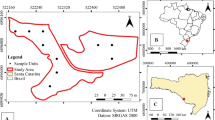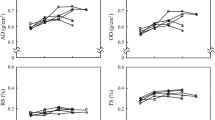Abstract
Forty young trees from a stand of maritime pine in the southern mountains of Galicia, Spain (42°21′N: 8°01′W) were felled to obtain the material required for studying density and shrinkage in clear and small wood specimens. The wood ranged from light to moderately heavy, and the dimensions remained reasonably stable with varying moisture content. The results were consistent with those obtained in previous studies of adult trees, except for axial shrinkage, which was very high and variable in this study. The between-tree variation in wood properties was high considering that the sampled trees came from the same stand. However, the relationships between density and height in the stem were similar in all trees. A general model for the prediction of volumetric shrinkage was developed, with oven-dry density and ring width as predictor variables. The model is feasible for estimation of wood quality in living trees. It is applicable to tree selection for thinning and for genetic improvement of stock.
Résumé
Propriétés physiques du bois d’éclaircies de pin maritime (Pinus pinaster Ait.). Des pièces en bois, petites et sans défauts, provenant de 40 jeunes pins maritimes d′un peuplement des montagnes du Sud de la Galicie, Espagne (42°21′N, 8°01′W), ont été testées. Le bois analysé était léger à demi-lourd et de dimensions relativement stables face aux variations d′humidité. Leurs propriétés: densité et rétractibilité correspondent aux données citées pour les arbres adultes; toutefois, la rétractibilité axiale est très élevée et possède une très grande dispersion. La variation des propriétés entre arbres est très significative; même entre les arbres qui procédaient d′un même peuplement. Par ailleurs, les relations entre les variables densité et hauteur sur la grume sont très similaires pour toutes les grumes. Un modèle est proposé en vue d′estimer la rétractibilité volumétrique, à partir de la densité et de la largeur de cerne. Le modèle permet de déterminer la qualité du bois dans des arbres vivants en utilisant comme critère de sélection des sujets dans les éclaircies et dans l′amélioration génétique.



Similar content being viewed by others
References
Aguiar A, Almeida MH, Borralho N (2003) Genetic control of growth, wood density and stem characteristics of Pinus pinaster in Portugal. Silva Lusit 11(2):131–139
Álvarez JG, Schröder J, Rodríguez R, Ruiz AD (2002) Modelling the effect of thinnings on the diameter distribution of even-aged maritime pine stands. For Ecol Manag 165(1–3):57–65
Boutelje JB (1962) The relationship of structure to transverse anisotropy in wood with reference to shrinkage and elasticity. Holzforschung 16(2):33–46
Cameron AD (2002) Importance of early selective thinning in the development of long-term stand stability and improved log quality: a review. Forestry 75(1):25–35. doi:10.1093/forestry/75.1.25
Carvalho AM (1994) A maritime pine thinning experiment. In: Proceedings of IUFRO meeting on mountain silviculture, pp 375–391
Casado M, García M, Acuña L (2001) Caracterización físico-mecánica del Pinus pinaster Ait. procedencia Sierra de Oña (Burgos), influencia del factor rectitud. In: Proceedings of III Congreso Forestal Español, vol V, pp 545–553
DGCONA (2002) Plan Forestal Español. Ministerio de Medio Ambiente, Madrid
Dumail JF, Castéra P (1997) Transverse shrinkage in maritime pine juvenile wood. Wood Sci Technol 31(4):251–264. doi:10.1007/BF00702613
Dumail JF, Castéra P, Morlier P (1998) Hardness and basic density variation in the juvenile wood of maritime pine. Ann Sci For 55(8):911–923. doi:10.1051/forest:19980804
European Committee for Standardization (2002) EN 13183-1:2002. Moisture content of a piece of sawn timber—part 1: Determination by oven dry method. European Committee for Standardization, Bruxelles
European Committee for Standardization (2003) EN 408:2003. Timber structures. Structural timber and glued laminated timber. Determination of some physical and mechanical properties. European Committee for Standardization, Bruxelles
European Committee for Standardization (2004) EN 384:2004. Structural timber. Determination of characteristic values of mechanical properties and density. European Committee for Standardization, Bruxelles
Fernández-Golfín JI, Díez MR (1996) Growth rate as a predictor of density and mechanical quality of sawn timber from fast growing species. Holz als Roh-und Werkst 54:171–174
Fonseca FMA (1989) Variaçao na madeira de Pinus pinaster Ait. Universidade de Trás-Os-Montes e Alto Douro, Vila Real Forest Products Laboratory (1999) Wood handbook-wood as an engineering material. Gen Tech Rep FPL-GTR-113. US Department of Agriculture, Forest Service, Madison
Gutiérrez A, Plaza F (1967) Características físico-mecánicas de las maderas españolas. IFIE, Madrid
Instituto Galego de Estatística (2008) Anuario de estatística agraria. Santiago de Compostela. Available via DIALOG. http://www.ige.eu. Accessed 24 Sep 2008
International Organization for Standardization (1975) ISO 3131:1975. Wood. Determination of density for physical and mechanical tests. International Organization for Standardization, Geneva
Kininmonth JA, Whitehouse LJ (1991) Properties and uses of New Zealand Radiata Pine, vol I, wood properties. New Zealand Ministry of Forestry, FRI, Christchurch
Koga S, Zhang SY (2004) Inter-tree and intra-tree variations in ring width and wood density components in balsam fir (Abies balsamea). Wood Sci Technol 38(2):149–162. doi:10.1007/s00226-004-0222-z
Kollmann F (1951) Technologie des Holzes und der Holzwerkstoffe, vol I. Springer, Berlin
Leban JM, Houllier F, Goy B, Colin F (1991) La qualité du bois d’épicéa commun en liason avec les conditions de croissance. For Entrep 80:13–26
Louzada JLPC (2003) Genetic correlations between wood density components in Pinus pinaster Ait. Ann Sci 60(3):285–294. doi:10.1051/forest:2003020
Louzada JLPC, Fonseca FMA (1991) Influência do crescimento em diâmetro (DAP) e da qualidade do local na variaçao da densidade em Pseudotsuga menziesii Mirb. (Franco). Série Técnica-Científica, 10. Universidade de Trás-Os-Montes e Alto Douro, Vila Real
Macdonald E, Hubert J (2002) A review of the effects of silviculture on timber quality of Sitka spruce. Forestry 75(2):107–138. doi:10.1093/forestry/75.2.107
Mazet JF, Nepveu G (1991) Relations between wood shrinkage properties and wood density for Scots pine, silver fir and Norway spruce. Ann Sci For 48(1):87–100. doi:10.1051/forest:19910107
Molina F (1993) El selvicultor privado y la política forestal. In: Proceedings of I Congreso Forestal Español, vol V, pp 15–23
Nicholls JWP (1970) Selecting Portuguese Pinus pinaster for tree improvement in Australia. Part II Wood quality assessment. J Inst Wood Sci 26(5):37–41
Ortiz J, Martínez JJ (1991) Características mecánicas de la madera de pino gallego obtenidas a partir de ensayos con piezas de tamaño estructural. Bol Inf Tec AITIM 150:95–101
Pot D, Chantre G, Rozenberg P, Rodrigues JC, Jones GL, Pereira H, Hannrup B, Cahalan C, Plomion C (2002) Genetic control of pulp and timber properties in maritime pine (Pinus pinaster Ait.). Ann Sci 59(5–6):563–575. doi:10.1051/forest:2002042
Prades C, Montero A, Rubio J (2001) Características físico-mecánicas de la madera de Pinus pinaster Ait., procedente de los montes del Marquesado (provincia de Granada). In: Proceedings of III Congreso Forestal Español, vol V, pp 665–670
Remacha A (1987) Características del pino gallego y sus aplicaciones. AITIM, Madrid
Rijsdijk JF, Laming PB (1994) Physical and related properties of 145 timbers: information for practice. Kluwer, Dordrecht
Rodríguez R, Álvarez JG, Schröder J (2000) Simulation and comparison of silvicultural alternatives for even-aged Pinus pinaster Ait stands in Galicia (Northwestern Spain). Ann Sci 57:747–754. doi:10.1051/forest:2000157
Xunta de Galicia (2001) O bosque galego en cifras. Consellería de Medio Ambiente, Santiago de Compostela
Zobel BJ, van Buijtenen JP (1989) Wood variation. Its causes and control. Springer, Berlin
Acknowledgments
We thank the Xunta de Galicia and the CICYT for supporting the project and Jorge Palacios Estremera for his comments on the manuscript.
Author information
Authors and Affiliations
Corresponding author
Additional information
Communicated by T. Seifert.
Rights and permissions
About this article
Cite this article
Riesco Muñoz, G., Barrio Anta, M. Physical properties of thinning wood in maritime pine (Pinus pinaster Ait.): case study. Eur J Forest Res 129, 1037–1045 (2010). https://doi.org/10.1007/s10342-010-0388-x
Received:
Revised:
Accepted:
Published:
Issue Date:
DOI: https://doi.org/10.1007/s10342-010-0388-x




